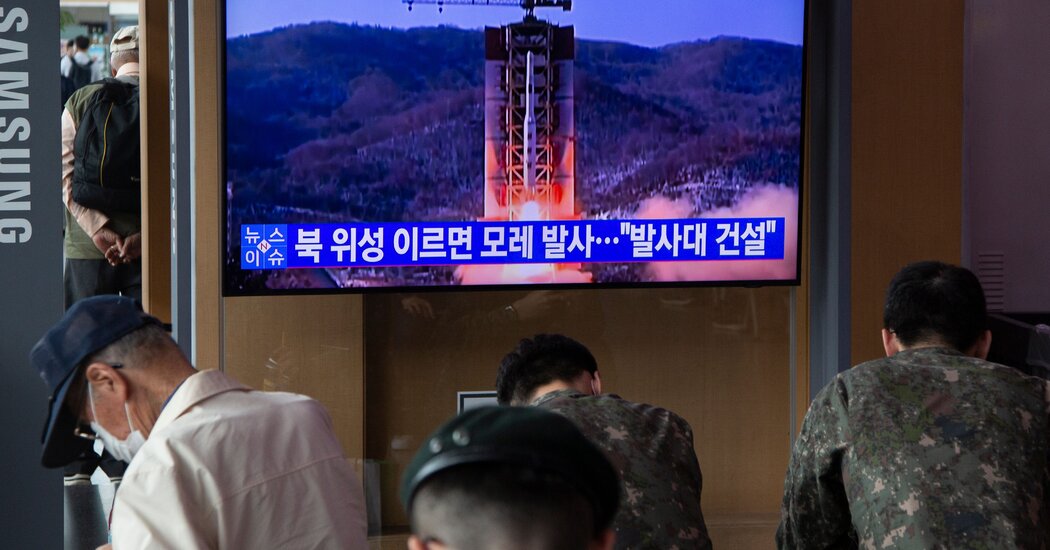Global Courant 2023-05-31 05:25:01
SEOUL — North Korea on Wednesday launched a spacecraft carrying its first military reconnaissance satellite, designed to track the militaries of South Korea and the United States and help the north conduct nuclear strikes more effectively, South Korean defense officials said.
As the missile hurtled south, a machine-generated automatic emergency text message told citizens in Seoul to prepare to evacuate, fearing debris from the North Korean missile could hit the South Korean capital. traps. The government later retracted the alarm, calling it a “false alarm.”
The South Korean military said the North Korean missile flew over the waters between the Korean peninsula and China.
Similarly, in Japan, the government sent warnings to Okinawa Prefecture urging residents to seek shelter inside and away from windows, but just after 7 a.m., the warning was lifted when the government announced that the missile was not heading for Japan. flew. Less than 10 minutes later, the Ministry of Defense announced that a projectile had already fallen into the water.
Wednesday’s launch signaled a space race that warmed up in the skies over the Korean peninsula. The United States, Russia, China and Japan already have satellites monitoring the peninsula, one of East Asia’s flashpoints. South Korea recently joined the fray by pledging to launch its first military spy satellite into orbit by 2025 and testing a launch rocket twice since March last year.
When North Korea’s leader Kim Jong-un, at a ruling Workers’ Party meeting in 2021, instructed his country to redouble its efforts to expand and diversify its nuclear arsenal, he made military spy satellites one of his priorities in orbit around the Earth
Spy satellites would make the north’s nuclear arsenal more dangerous by turning its military eyes to the sky, military experts say. They would also help North Korea collect data from its missile tests as the country struggles to perfect its intercontinental ballistic missile technologies.
But experts have also questioned the capabilities of the North’s prototype satellite, which the North said would be carried by the rocket launched Wednesday.
The missile lifted off from a launch pad in Tongchang-ri in North Korea’s northwestern corner. The missile was programmed to fly over the sea between China and the Korean Peninsula and over the waters east of the Philippines. As the countdown began, South Korea and Japan put their militaries on high alert in case debris fell on their territory.
They had both urged Pyongyang to cancel the launch of the satellite and condemned it as a dangerous provocation.
Under a series of United Nations Security Council resolutions, North Korea is barred from launching space missiles, as well as testing nuclear weapons and ballistic missiles that could be used to launch them. North Korea insists on its right to a peaceful space program, but Washington and its allies have long accused the country of using such a program as a cover for testing intercontinental ballistic missile technologies.
In recent months, Washington and its allies have expanded their joint military exercises to help protect against North Korea’s growing nuclear and missile threats. They plan to have one Proliferation security initiative exercise on Wednesday, when their navies will practice banning ships carrying weapons of mass destruction material to and from countries like North Korea. Last week, the US and South Korean militaries also began the first of a series of live-fire exercises planned through mid-June near the border with North Korea.
The “dangerous military actions of the US and its vassal forces” are forcing North Korea to secure “a reliable reconnaissance and information resource,” Ri Pyong Chol, vice chairman of the North’s Central Military Commission, said Monday, when he revealed the plan to launch the North’s “Military Reconnaissance Satellite No. 1.”
North Korea’s space and ICBM programs are closely intertwined.
In 2012, months after Kim came to power, North Korea launched a missile that it said carried a satellite. Much to the embarrassment of the young leader, the rocket disintegrated shortly after launch. But eight months later, another North Korean missile flew as far as the Philippines. North Korea last claimed to have launched a satellite in 2016, when the missile also flew over the sea near the Philippines.
None of these missiles were believed to carry an advanced satellite. But their launches showed that the North was making progress in building a rocket powerful enough to deliver a satellite to orbit or a nuclear warhead at intercontinental range.
The country conducted its first ICBM test in 2017.
North Korea ramped up its space and ICBM programs after Mr Kim’s diplomacy with President Donald J. Trump collapsed in 2019.
When it tested missiles off the East Coast in February and March last year, it claimed to have done so in preparation for a satellite launch. But South Korea accused the North of testing a missile for its new Hwasong-17 ICBM. In November, the North conducted its first successful test of the Hwasong-17.
In December, the country ground-tested a new solid-fuel booster rocket, a major upgrade in the North’s ICBM program because solid-fuel rockets can launch faster and are harder to intercept. In the same month, North Korea launched missiles which the South called missile tests, but according to the North, tests of satellite-launching technologies.
In April, North Korea conducted the first test flight of the Hwasong-18, the first solid fuel ICBM.
It was unclear whether the rocket carrying the satellite on Wednesday was the liquid-fuel rocket that powered the Hwasong-17 or the solid-fuel engine that powered the Hwasong-18.
Choe Sang-Hun reported from Seoul and Motoko Rich from Tokyo.








